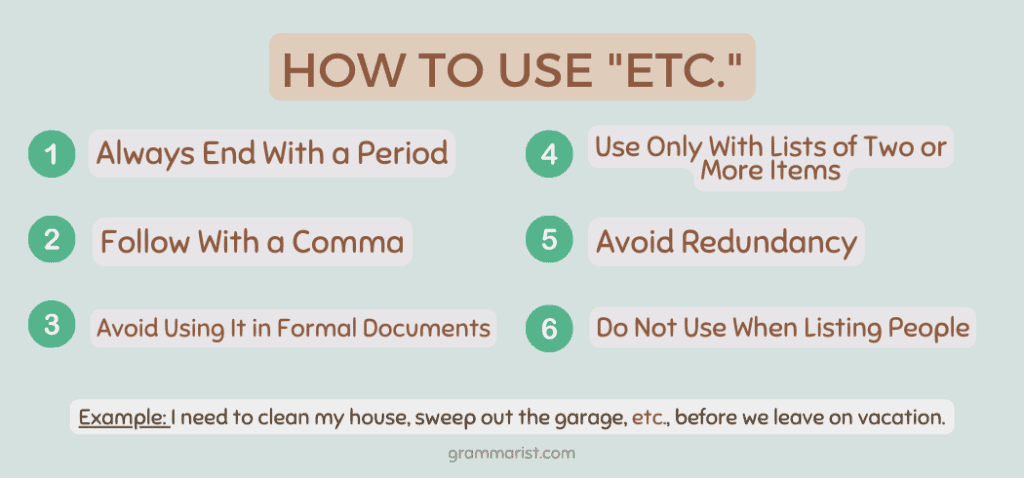When naming off items in a list, many people choose to include the abbreviation, etc., to help avoid creating long, rambling sentences. It quickly allows the reader to understand that other items in the list are related to one another and are not important to the overall understanding of the author’s message.
Etc. is mostly used in informal, business, and technical writing. When used in parentheses, follow the same rules of use when included in regular sentences. Let’s look briefly at how to use etc. in a sentence and where it belongs in parentheses.
What Does “Etc.” Mean?
Etc. is actually an abbreviation of et cetera, a Latin phrase that means and (et) the rest (cetera).
It is placed at the end of a short list you do not plan on completing and indicates there are more items in the list other than those already included.
It is commonly used in technical and business writing, such as informal memos and internal communications.
How Is “Etc.” Used?

There are a few basic rules to follow when using etc. in a sentence.
Rule #1: Always End With a Period
Etc. should always end in a period since it is an abbreviation. This is always the same, even if placed in the middle of a sentence. It is not followed by a second period if placed at the end of a sentence.
For example:
- I’m running to the store to pick up bread, milk, cereal, etc., to get us through the week.
- She made sure to pack the toiletries, towels, etc.
Rule #2: Follow With a Comma
Etc. always used to be followed by a comma before the continuation of a sentence. However, it is now appropriate to omit the comma. You can choose to do either.
For example:
- I need my students to turn in their papers, materials, presentations, etc., before the end of the week.
- I need my students to turn in their papers, materials, presentations, etc. before the end of the week.
Rule #3: Avoid Using It in Formal Documents
It is often suggested to avoid using etc. in any context unless absolutely necessary. Of course, this is not an opinion held by all, but you should keep its use restricted to informal communication, such as lists, tables, notes, and parenthetical use.
Rule #4: Use Only With Lists of Two or More Items
Do not follow only one item with etc. Always use it after two or more items in a list.
For example:
- I need to clean my house, sweep out the garage, etc., before we leave on vacation.
Rule #5: Avoid Redundancy
Avoid placing the word “and” before etc. Etc. means “and the rest” so “and etc.” would mean “and and the rest.”
Also, never use etc. at the end of a list that begins with the phrases “such as,” “for example,” “including,” or similar since they already imply the writer could provide other examples.
Rule #6: Do Not Use When Listing People
The Latin et alii means “and other people,” and we use the abbreviation et al., to indicate there are more people listed than what is in the sentence.
Etc. indicates there are more things, not people.
For example:
- The authors John Kernan, Robert Smith, et al. were invited to the gala.
Rules of Parentheses Use
Parentheses also have a few rules of use you need to be aware of. However, only two rules are important when using etc. with them.
Rule #1: Enclose Nonessential Details or Information Only
Parentheses are included in a sentence when the author wants to include more information for the reader. The information lends detail or clarity but is not necessary to the overall understanding of the sentence.
For example:
- To get to the office, be sure to turn left at Davis Street (there is a drug store on that corner).
Rule #2: Enclose Digression or an Afterthought
Parenthesis can also offer a thought or digression related to the subject of the sentence. Again, the information included is not necessary but can help the reader better understand the tone or thoughts of the author.
For example:
- We finally received an email about the meeting (it took long enough) and what we needed to have prepared to present.
How to Use “Etc.” in Parentheses
The rules of etc. usage do not change even when they are used within a paragraph. However, if you use etc. at the end of a sentence in parentheses, you still add the period after the closing parentheses.
For example:
- We had a harsh winter (freezing temps, daily snowfall, etc.) last year.
- I will need you to run to the store after work today to pick up necessities (soap, garbage bags, etc.).
Let’s Review
Etc. is added to lists to mean “and the rest” to avoid having to list out all items or ideas being presented. It is almost exclusively used in informal, written communication, and its rules of use do not change when placed within parentheses.
